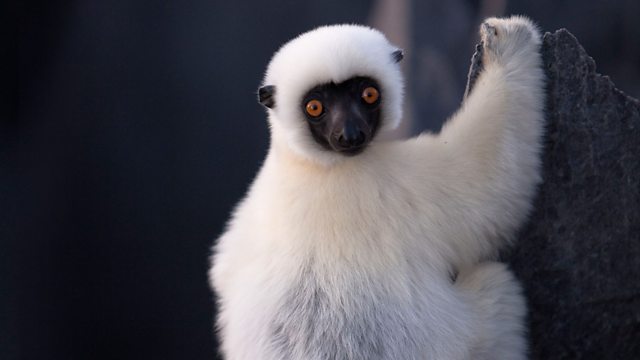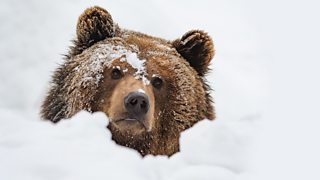Madagascar
Journey across Madagascar, the oldest island on Earth. Over time, it has given rise to more unique plants and animals, from its lemurs to chameleons, than any other island.
Journey across the tropical island of Madagascar and explore the unique and incredible wildlife it has to offer - from its famed lemurs to chameleons.
As the oldest island on Earth, life has had time to evolve, and there are now more unique plants and animals on Madagascar than any other island.
It was formed nearly 90 million years ago when a giant landmass split apart, and Madagascar was cast adrift from east Africa. Braving the 400-mile ocean crossing from Africa, the first castaways arrived on the arid west of the island, and were met with vast deserts.
Ring-tailed lemurs are the direct descendants of one of the very first mammals to arrive, and they are thriving despite the arid conditions. They spend up to eight hours a day foraging in the Spiny Forest. Their plant-based diet includes plants with caustic sap that would burn human skin.
When humans arrived on the west coast, they too faced the hostile desert, high temperatures and droughts that can last a year. In the village of Ampotaka, the people have learnt to use baobab trees to help them survive. The trees grow up to 30 metres high and stores vast quantities of water in their trunks. By hollowing out the inside of the trunk, the people create huge water tanks storing thousands of litres of water, which they can use when times are tough.
Tiny labord’s chameleons are unique to Madagascar and have the shortest lifespan of any land vertebrate – living for just four months. They time their hatching with the start of the rainy season when the going is good, and then the race is on for them to grow, mate and lay eggs before the dry season comes round once again.
One of the most dramatic places in Madagascar is known as the Grand Tsingy – 500 square miles of sharp limestone pinnacles sheltering small pockets of forest. To survive here, Decken’s sifakas must climb these shards of rock, sharp enough to shred human skin, and leap 30 feet between them.
A series of even higher peaks forms a mountainous spine running down the middle of Madagascar. Just a few thousand years ago, human settlers from Asia brought the skills to turn the steep mountainsides into rice paddies. By digging terraces into the slopes, even the steepest gradients can be farmed, producing more than a million tonnes of rice every year. But only if they can keep their crop safe from the devastating plagues of locusts in their billions.
Madagascar’s mountain range defines the islands’ climate. It blocks warm, wet air blown in off the Indian Ocean to the east, creating the arid deserts of the west. But keeping all this moisture to the eastern side of the island makes rainfall high there, and this creates bountiful rainforests.
Most of the island’s incredible wildlife can be found within these tropical rainforests, including tenrecs, Madagascar’s own unique version of a hedgehog. They give birth to more babies than any mammals – as many as 32 in a litter. The streaked tenrec rubs together modified spines on her back to make a squeaking noise to warn all her babies of danger.
The extraordinary pelican spider twangs the threads of an orb web spider to lure it into its giant jaws. The aye-aye is one of Madagascar’s weirdest creatures, found hunting for insect larvae at night. It uses it bizarre 9cm-long middle finger to tap tree branches for hollow bits, before scraping away the bark and deploying its super-sized finger to fish out the grubs.
Madagascar’s unique wildlife has slowly been evolving for millions of years, but since humans arrived the pace of change has been faster than many animals can cope with. As little as 20 per cent of the island’s original forest remains, and 95 per cent of lemurs are now threatened with extinction.
The greater bamboo lemur is a story of how efforts to protect Madagascar’s wildlife can save a species from being wiped out entirely. These lemurs were thought to have gone extinct, thanks to the clearance of the bamboo forests they rely on for food. The bamboo lemurs are now protected and in the last year, a record number of babies were born. Madagascar is at a critical point, but with the right efforts, there is some hope for its wildlife in the future.
Last on
More episodes
Previous
You are at the first episode
Next
Clips
-
![]()
Bladerunners of Madagascar
Duration: 02:56
-
![]()
The rice paddies of Madagascar
Duration: 03:07
-
![]()
The lemurs of Madagascar
Duration: 01:12
Music Played
-
![]()
Hans Zimmer, Jacob Shea & David Fleming
Surfing Dolphins
Credits
| Role | Contributor |
|---|---|
| Narrator | David Harewood |
| Producer | Sara Douglas |
| Series Producer | Kathryn Jeffs |
| Executive Producer | Mark Brownlow |
| Production Manager | Dulcie Arnold |
| Composer | Michael Kruk |
Broadcasts
- New Year's Day 2020 21:00
- Sat 4 Jan 2020 19:15���˿��� Two except Wales & Wales HD
- Sun 5 Jan 2020 17:00���˿��� Two Wales & Wales HD only
- Thu 6 Feb 2020 01:45
- Sat 19 Sep 2020 20:00
- Sun 2 Jan 2022 18:00���˿��� Two except Wales & Wales HD
- Mon 6 Jun 2022 20:00
- Tue 7 Jun 2022 02:25
- Sun 30 Jul 2023 20:00
- Boxing Day 2023 19:00
- Wed 27 Dec 2023 02:50
- Tue 8 Oct 2024 16:15���˿��� Two except Wales & Wales HD
- Christmas Eve 2024 23:40
- Christmas Day 2024 02:55
Featured in...
![]()
Earth Day
Facts about the environment and the challenges facing our planet to mark Earth Day.
![]()
Escape to Nature
Cast off the stress and relax with stunning images from the natural world.
![]()
Wildlife
Compelling wildlife documentaries, featuring amazing animals and stunning landscapes
![]()
Here Comes the Summer
Sun-kissed TV guaranteed to get you into the holiday spirit.
![]()
Science & Nature
Discovering the ���˿��� 's Signed Science & Natures programmes








